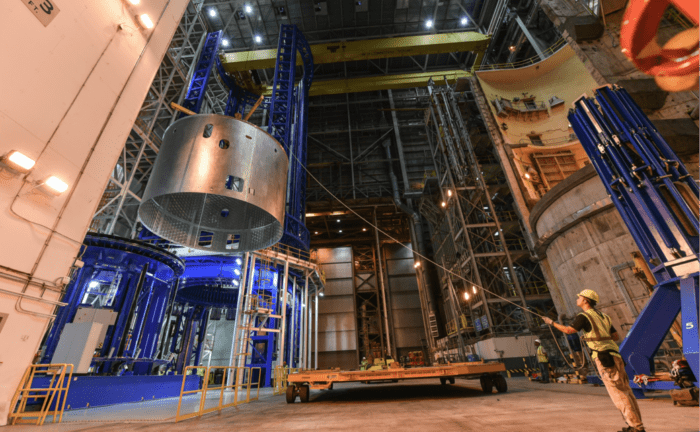NASA Welds First Flight Section of SLS Core Stage for 2018 Maiden Launch

One weld at a time, the flight hardware for NASA’s mammoth new Space Launch System (SLS) booster has at last started taking shape, promising to turn years of planning and engineering discussions into reality and a rocket that will one day propel our astronauts on a ‘Journey to Mars.’The first actual SLS flight hardware has been assembled, leaping from engineering blueprints on computer screens to individual metallic components that technicians are feeding into NASA’s gigantic “Welding Wonder” machine at the agency’s Michoud Assembly Facility in New Orleans.Technicians are bending metal and have now finished welding together the pieces of flight hardware forming the first major SLS flight component – namely the engine section that sits at the base of the SLS core stage.The engine section of the core stage will house the four RS-25 engines that will power the maiden launch of SLS and NASA’s Orion deep space manned spacecraft in late 2018.The core stage towers over 212 feet (64.6 meters) tall, sports a diameter of 27.6 feet (8.4 m) and stores the cryogenic liquid hydrogen and liquid oxygen that feeds and fuels the boosters RS-25 engines.SLS will be the most powerful rocket the world has ever seen. It will propel astronauts in the Orion capsule on deep space missions, first back to the Moon by around 2021, then to an asteroid around 2025 and then beyond to the Red Planet in the 2030s – NASA’s overriding and agency wide goal.The SLS core stage welding work is carried out in the massive 170-foot-tall Vertical Assembly Center (VAC) at Michoud. Boeing is the prime contractor for the SLS core stage.On Sept. 12, 2014, NASA Administrator Charles Bolden officially unveiled VAC as the world’s largest welder at Michoud.”This rocket is a game changer in terms of deep space exploration and will launch NASA astronauts to investigate asteroids and explore the surface of Mars while opening new possibilities for science missions, as well,” said NASA Administrator Charles Bolden during the ribbon-cutting ceremony at Michoud.Each of the RS-25’s engines generates some 500,000 pounds of thrust, fueled by cryogenic liquid hydrogen and liquid oxygen. They are recycled for their original use as space shuttle main enginesFor SLS they will be operating at 109% of power, compared to a routine usage of 104.5% during the shuttle era. They measure 14 feet tall and 8 feet in diameter.The SLS weld team has been busy. Technicians have already assembled a qualification version of the engine section on the Vertical Assembly Center at Michoud. Later this year it will be shipped to NASA’s Marshall Space Flight Center in Huntsville, Alabama, to undergo structural loads testing.In March, they also completed welding of a liquid oxygen tank confidence article on the Vertical Assembly Center. And in February they welded the liquid hydrogen tank confidence article.According to the current schedule, NASA plans to finish all welding for the core stage — including confidence, qualification and flight hardware — of the SLS-1 rocket sometime this summer.Engineers are constructing the confidence and qualification hardware units to verify that the welding equipment and procedures work exactly as planned.“The confidence will also be used in developing the application process for the thermal protection system, which is the insulation foam that gives the tank its orange color,” say NASA officials.Altogether , the SLS first stage propulsion comprises the four RS-25 space shuttle main engines and a pair of enhanced five segment solid rocket boosters (SRBs) also derived from the shuttles four segment boosters.The maiden test flight of the SLS/Orion is targeted for no later than November 2018 and will be configured in its initial 70-metric-ton (77-ton) version with a liftoff thrust of 8.4 million pounds.Meanwhile the welded skeletal backbone for the Orion EM-1 mission recently arrived at the Kennedy Space Center on Feb. 1 for outfitting with all the systems and subsystems necessary for flight.Stay tuned here for Ken’s continuing Earth and Planetary science and human spaceflight news. Ken Kremer
The post NASA Welds First Flight Section of SLS Core Stage for 2018 Maiden Launch appeared first on Universe Today.

